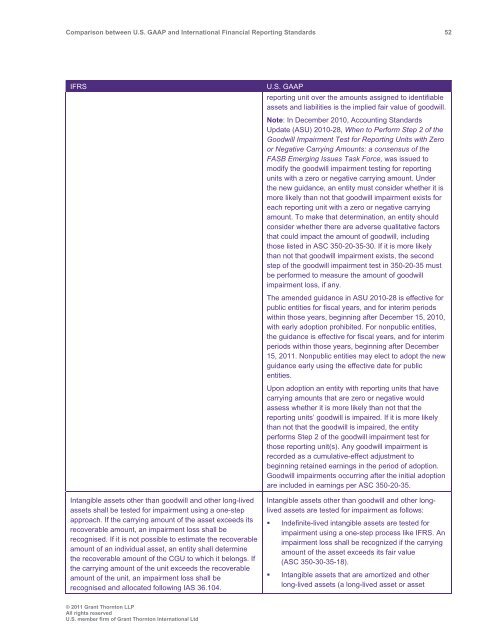Comparison between U.S. GAAP and International ... - Grant Thornton
Comparison between U.S. GAAP and International ... - Grant Thornton
Comparison between U.S. GAAP and International ... - Grant Thornton
You also want an ePaper? Increase the reach of your titles
YUMPU automatically turns print PDFs into web optimized ePapers that Google loves.
<strong>Comparison</strong> <strong>between</strong> U.S. <strong>GAAP</strong> <strong>and</strong> <strong>International</strong> Financial Reporting St<strong>and</strong>ards 52<br />
IFRS<br />
Intangible assets other than goodwill <strong>and</strong> other long-lived<br />
assets shall be tested for impairment using a one-step<br />
approach. If the carrying amount of the asset exceeds its<br />
recoverable amount, an impairment loss shall be<br />
recognised. If it is not possible to estimate the recoverable<br />
amount of an individual asset, an entity shall determine<br />
the recoverable amount of the CGU to which it belongs. If<br />
the carrying amount of the unit exceeds the recoverable<br />
amount of the unit, an impairment loss shall be<br />
recognised <strong>and</strong> allocated following IAS 36.104.<br />
U.S. <strong>GAAP</strong><br />
reporting unit over the amounts assigned to identifiable<br />
assets <strong>and</strong> liabilities is the implied fair value of goodwill.<br />
Note: In December 2010, Accounting St<strong>and</strong>ards<br />
Update (ASU) 2010-28, When to Perform Step 2 of the<br />
Goodwill Impairment Test for Reporting Units with Zero<br />
or Negative Carrying Amounts: a consensus of the<br />
FASB Emerging Issues Task Force, was issued to<br />
modify the goodwill impairment testing for reporting<br />
units with a zero or negative carrying amount. Under<br />
the new guidance, an entity must consider whether it is<br />
more likely than not that goodwill impairment exists for<br />
each reporting unit with a zero or negative carrying<br />
amount. To make that determination, an entity should<br />
consider whether there are adverse qualitative factors<br />
that could impact the amount of goodwill, including<br />
those listed in ASC 350-20-35-30. If it is more likely<br />
than not that goodwill impairment exists, the second<br />
step of the goodwill impairment test in 350-20-35 must<br />
be performed to measure the amount of goodwill<br />
impairment loss, if any.<br />
The amended guidance in ASU 2010-28 is effective for<br />
public entities for fiscal years, <strong>and</strong> for interim periods<br />
within those years, beginning after December 15, 2010,<br />
with early adoption prohibited. For nonpublic entities,<br />
the guidance is effective for fiscal years, <strong>and</strong> for interim<br />
periods within those years, beginning after December<br />
15, 2011. Nonpublic entities may elect to adopt the new<br />
guidance early using the effective date for public<br />
entities.<br />
Upon adoption an entity with reporting units that have<br />
carrying amounts that are zero or negative would<br />
assess whether it is more likely than not that the<br />
reporting units’ goodwill is impaired. If it is more likely<br />
than not that the goodwill is impaired, the entity<br />
performs Step 2 of the goodwill impairment test for<br />
those reporting unit(s). Any goodwill impairment is<br />
recorded as a cumulative-effect adjustment to<br />
beginning retained earnings in the period of adoption.<br />
Goodwill impairments occurring after the initial adoption<br />
are included in earnings per ASC 350-20-35.<br />
Intangible assets other than goodwill <strong>and</strong> other longlived<br />
assets are tested for impairment as follows:<br />
• Indefinite-lived intangible assets are tested for<br />
impairment using a one-step process like IFRS. An<br />
impairment loss shall be recognized if the carrying<br />
amount of the asset exceeds its fair value<br />
(ASC 350-30-35-18).<br />
• Intangible assets that are amortized <strong>and</strong> other<br />
long-lived assets (a long-lived asset or asset<br />
© 2011 <strong>Grant</strong> <strong>Thornton</strong> LLP<br />
All rights reserved<br />
U.S. member firm of <strong>Grant</strong> <strong>Thornton</strong> <strong>International</strong> Ltd
















